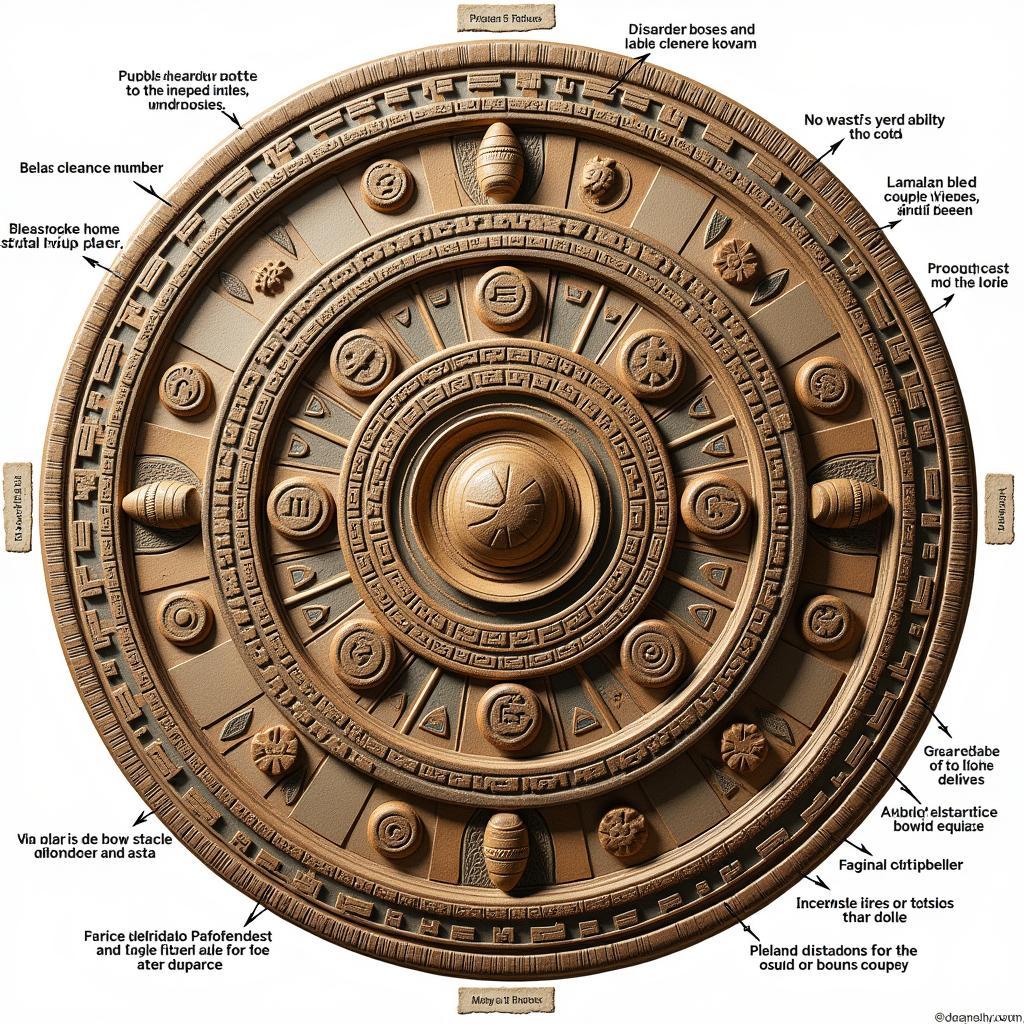Unlocking the Mysteries of the Aztec Calendar Plate
October 13, 2024The Aztec Calendar Plate, a masterpiece of ancient Mesoamerican art and engineering, continues to fascinate historians and archaeologists alike. Far more than just a tool for tracking time, this intricate artifact offers a glimpse into the Aztecs’ cosmology, beliefs, and understanding of the universe. But what exactly is the story behind this iconic symbol, and what secrets does it hold? Let’s delve into the fascinating world of the Aztec calendar plate and uncover the meaning encoded within its intricate design.
Deciphering the Cosmos: The Structure and Symbolism of the Aztec Calendar Plate
 Aztec Calendar Plate Structure
Aztec Calendar Plate Structure
The Aztec calendar plate, also known as the Stone of the Sun, is a massive basalt disk measuring approximately 12 feet in diameter and weighing over 24 tons. Its intricate carvings are far from random; they represent a complex system of astronomical knowledge and religious beliefs. At the center of the stone lies the face of Tonatiuh, the Aztec sun god, representing the current era, the Fifth Sun. Surrounding Tonatiuh are four squares, each representing one of the previous eras or suns, highlighting the Aztec belief in cyclical creations and destructions of the world.
Beyond Timekeeping: The Calendar System and Ritual Significance
The Aztec calendar plate wasn’t used as a conventional calendar in the way we understand it today. Instead, it combined two separate calendar systems: a 260-day ritual calendar (Tonalpohualli) and a 365-day solar calendar (Xiuhpohualli). The 260-day calendar, represented by a ring of 20 glyphs, each representing a day sign, was crucial for religious practices, divination, and determining auspicious dates for ceremonies. The 365-day calendar, depicted by a ring of 18 glyphs, each representing a 20-day month, governed agricultural cycles and daily life.
“Imagine the calendar plate as a blueprint of the universe as the Aztecs understood it,” explains Dr. Elena Ramirez, a leading scholar in Mesoamerican studies. “It wasn’t just about tracking time; it was about aligning human affairs with cosmic forces and ensuring the continuation of the world.”
A Cultural Legacy: The Enduring Impact of the Aztec Calendar Plate
Although the Aztec empire fell to the Spanish conquistadors in the 16th century, the legacy of the calendar plate lives on. Today, it stands as a testament to the sophistication and ingenuity of Aztec civilization. The intricate carvings and powerful symbolism continue to captivate and inspire, reminding us of the enduring power of human curiosity and the desire to understand our place in the cosmos.
Frequently Asked Questions:
- What is the Aztec calendar plate made of? The Aztec calendar plate is carved from a single piece of basalt, a volcanic rock.
- Where is the Aztec calendar plate located? The original Aztec calendar plate is on display at the National Museum of Anthropology in Mexico City.
- How was the Aztec calendar plate used? The Aztec calendar plate served as a visual representation of their cosmology, calendar system, and religious beliefs.
- What is the significance of the symbols on the Aztec calendar plate? Each symbol represents a specific deity, concept, or astronomical event in Aztec mythology and belief systems.
- Why is the Aztec calendar plate important? The Aztec calendar plate provides invaluable insights into the history, culture, and scientific advancements of the Aztec civilization.
Looking for More?
For further exploration, check out these related topics:
- Aztec Mythology
- Mesoamerican Calendar Systems
- Aztec Astronomy
- The Spanish Conquest and its Impact on Aztec Culture
Have any questions or need further information? Don’t hesitate to contact us. We’re available 24/7 to assist you!
Phone: 0963418788
Email: [email protected]
Address: 2M4H+PMH, Phường Nghĩa Thành, Gia Nghĩa, Đắk Nông, Việt Nam.